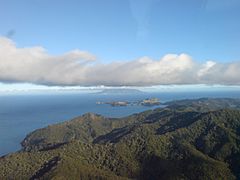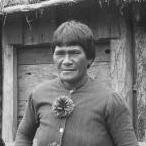Little Barrier Island facts for kids
|
Māori: Te Hauturu-o-Toi
Nickname: Hauturu
|
|
|---|---|

View from the mainland
|
|
| Geography | |
| Location | Hauraki Gulf, Auckland Region |
| Coordinates | 36°11′57″S 175°04′53″E / 36.1991°S 175.0814°E |
| Area | 28.17 km2 (10.88 sq mi) |
| Length | 7.5 km (4.66 mi) |
| Width | 5.5 km (3.42 mi) |
| Highest elevation | 722 m (2,369 ft) |
| Highest point | Mount Hauturu |
| Administration | |
| Demographics | |
| Population | No permanent inhabitants |
| Additional information | |
| Wildlife sanctuary | |
Little Barrier Island, or Hauturu in Māori language (the official Māori title is Te Hauturu-o-Toi), lies off the northeastern coast of New Zealand's North Island. Located 80 kilometres (50 mi) to the north of Auckland, the island is separated from the mainland to the west by Jellicoe Channel, and from the larger Great Barrier Island to the east by Cradock Channel. The two aptly named islands shelter the Hauraki Gulf from many of the storms of the Pacific Ocean.
Settled by Māori sometime between 1350 and 1650, the island was occupied by those people until the New Zealand government declared the island a wildlife sanctuary in 1897. Since the island came under control of the government, it has been under limited access, with only a few rangers living on the island. In the Māori language, the name of the island name means "the resting place of lingering breezes". Along with its larger neighbour Great Barrier, it was given its English name by Captain James Cook in 1769.
The island is a nature sanctuary which has been described by the MBIE as "the most intact [native] ecosystem in New Zealand". However, several invasive species were introduced by both Maori and European settlers, including cats, which were destructive to local small bird and reptile species until they were eradicated between July 1977 and June 1980 in what was possibly New Zealand's costliest pest control programme.
History

Māori occupied the island for centuries prior to the first European visits, probably first settling there between 1350 and 1650 CE. The initial occupation was by descendants of Toi te Huatahi, followed by Tainui, who were then conquered by Ngāti Wai. By 1881 only a few Ngāti Wai were still living there and the British Crown attempted to buy the island in order to turn it into a nature reserve. After the purchase fell through, the island was instead appropriated through an Act of Parliament in 1894 and became New Zealand's first nature reserve the following year. Maori such as Rahui Te Kiri were evicted from the island by force in 1896. Since 1897, there has always been a caretaker or ranger resident on the island. In 2011 the crown settled treaty claims with local iwi, Hauturu was returned to iwi who in turn gifted it back to the people of Aotearoa.
Access is heavily restricted for conservation reasons, and the island is uninhabited except for rotational conservation staff, scientists and rangers under the authority of the Department of Conservation. Electricity for their needs was provided by a diesel generator linked to a battery bank until 2005, and has since been replaced by twenty 175-watt solar panels, with the generator remaining solely for backup. Over the expected 20-year life-span, the new system is expected to generate fuel savings sufficient to replace its purchase costs.
Stonework
Māori stonework has been found in fourteen locations on the island, primarily around the coastal flats at Te Titoki Point. Man-made cuttings, which were described in 1895 as ruts for hauling canoes, can be seen on the boulder beach ridge at Te Titoki Point. There are also stone rows measuring up to 60 metres (200 ft) long, 2 metres (6 ft 7 in) wide and 0.5 metres (1 ft 8 in) high, located near the mouth of Te Waikohare Stream.
Stone rows and heaps can be found 200 metres (660 ft) to 500 metres (1,600 ft) from the mouths of Te Waikohare and Tirikawa Streams. The largest is 2 metres (6 ft 7 in) high and 4 metres (13 ft) wide. The most extensive stonework is located in the northwest of the island, near the ridge south of Te Hue Stream, where it is spread over several hectares. This site includes a number of terraces, which are stone-faced or have stone retaining walls. There are also numerous stone heaps and rows, and several free standing stone walls.
Stonework in the northeast of the island is more weathered than in other areas and partially buried. Because of this weathering these features are thought to be older than at the other sites.
Geography
The island is an extinct andesitic stratovolcano, roughly circular in shape, about 6 km (3.7 mi) across, with an area of 28 km2 (11 sq mi). Its earliest volcanic activity is estimated to have occurred 3 million years ago and the latest 1.2 million years ago. The volcano is most closely related to two volcanoes over 120 km (75 mi) northwest, near Whangarei. The island is steeply sloping, and deeply dissected by ravines radiating from a central range that peaks at Mount Hauturu whose altitude is 722 m (2,369 ft). Te Titoki Point is the only area of flat land on the island.
Environment
A dense forest cover shelters numerous rare or endangered animal species. The total number of species of native plants is thought to range around 400, and the island may shelter more endangered birds than any other island in New Zealand. The island has been identified as an Important Bird Area by BirdLife International because it is a nesting site for vulnerable Cook's and Parkinson's petrels. In February 2013, there were reports of the critically endangered New Zealand storm petrel (Oceanites maorianus) breeding on the island. Kakapo (night parrots), also critically endangered, were (re)introduced to the island in 2012; as of July 2017, their population on the island stood at 14.

When Māori occupied the island, as much as a third of the island was cleared of forest. However, since the acquisition of the land by the New Zealand government, all but 20 hectares of the island have been reforested.
Bryde's whales, Orcas and Bottlenose dolphins live in the waters around the island. Blue whale and Southern right whales rest in this area during migration. In 2012, there were reports that a southern right whale may have calved near the island.
Invasive Species
Mammals
The Pacific rat or kiore (Rattus exulans). were likely introduced as invasive species during the initial settlement of the island by Māori. Eradication took place by aerial dropped poison baits in 2004.
Feral cats arrived on the island in the early 1870s. As in other places where predatory species were introduced, small animals not accustomed to predation likely experienced a decline in population, being pushed towards endangerment or extinction. In a survey of studies about eradicating the cats, scientist C.R. ("Dick") Veitch mentions several small species which were likely affected by the cats, including small reptiles and birds, such as the North Island snipe (Coenocorypha barrierensis), which only survived into the European era on this island and was formerly distributed across the entirety of the North Island, North Island saddleback (Philesturnus rufusater), grey-faced petrel (Pterodroma macroptera gouldi), Cook's petrel (Pterodroma cookii) and black petrel (Proeellaria parkinsoni). In the July 1977 to 23 June 1980 period, eradication was completed by a dedicated team, and 151 cats were killed using traps and poison.
Insects
Introduced wasps (German, Common, Asian Paper, and Tasmanian paper wasps) are all present on the island; in some years wasps are in plague numbers.
Plants
Prior to 1995 very little attention was paid to weed species on the island. The rangers' garden had been planted in exotics and bird and wind dispersed colonisers were spreading fast. In 1996 a weed control programme based in the successful work on the Kermadecs was implemented with teams of weeders grid searching the island. The main target species were Climbing Asparagus, Mexican Devil and Mist Flower.
See also
 In Spanish: Little Barrier Island para niños
In Spanish: Little Barrier Island para niños



